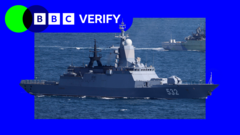Did a Russian Naval Ship Really Disguise Itself in the English Channel?

Understanding the Tactics of Disguise in Maritime Operations
The recent revelation regarding a Russian corvette, the Boikiy, utilizing a fake ID signal while traversing the English Channel alongside two sanctioned oil tankers raises significant questions about maritime security and the lengths nations may go to in order to circumvent sanctions. Through a detailed investigation, it has become evident that this act is not merely a one-off incident but part of a broader strategy employed by Russia to maintain its oil supply chains under international scrutiny. This article delves into the intricate details surrounding this event, the implications for maritime law enforcement, and the potential geopolitical consequences.
The Disguise: A Tactical Overview
The Boikiy, an armed corvette, was detected broadcasting a false identification code as it sailed through the English Channel. This deceptive maneuver is indicative of the growing sophistication of maritime operations, particularly among nations looking to protect their economic interests while facing international sanctions.
What Led to the Disguise?
Several factors appear to have prompted this operation:
- Sanctions and Economic Pressure: With increasing restrictions on Russian oil exports, the need to transport oil discreetly has intensified. The use of a false ID serves to mask the true identity of vessels involved in transporting sanctioned goods.
- Military Protection: The involvement of military vessels such as the Boikiy suggests a strategic response aimed at deterring Western nations from interfering with the operations of the shadow fleet.
- Escalating Tensions: The geopolitical landscape has become increasingly fraught, with incidents of military aircraft and naval vessels engaging in close encounters, prompting a need for heightened operational security.
The Mechanics of Maritime Disguise
The use of a fake ID signal is a calculated decision. The Automatic Identification System (AIS) is a critical tool for maritime navigation, allowing vessels to communicate their identity, position, and course. However, military vessels often operate without broadcasting their AIS signals, making it easier to maneuver undetected. By adopting a fake ID, the Boikiy was able to blend in with legitimate traffic, thereby reducing the risk of interception.
Tracking the Boikiy: The Investigation
BBC Verify's investigation employed satellite imagery and tracking data to confirm the identity of the Boikiy. The analysis revealed that the ship, despite its efforts to disguise itself, could be linked back to its original identification through various means:
- Satellite Imagery: High-resolution images confirmed the size and shape of the Boikiy, distinguishing it from other vessels using the same ID.
- Video Footage: Visual evidence of the vessel passing under a bridge in Denmark provided additional confirmation of its identity.
- Tracking Data Analysis: The movement patterns of the Boikiy were analyzed alongside its companions, the Sierra and Naxos, which further corroborated its identity.
The Shadow Fleet: An Overview
The concept of a "shadow fleet" involves a network of vessels that operate under the radar, often changing ownership and flags to obscure their true affiliations. This fleet has become increasingly vital for Russia as it seeks to navigate international sanctions.
Characteristics of the Shadow Fleet
- Obscured Ownership: Many vessels in this fleet are controlled by shell companies, making it difficult to trace their ownership.
- Flag Hopping: Ships frequently change flags to avoid detection and sanctions enforcement.
- Use of Deceptive Signals: As demonstrated by the Boikiy, employing fake identification codes is a tactic used to blend in with legitimate maritime traffic.
Recent Developments in the Shadow Fleet
Recent Western actions against the shadow fleet have included increased surveillance and maritime patrols. This has likely prompted Russia to enhance its protective measures for these vessels, including military escorts. The incident involving the Su-35 fighter jet entering Estonian airspace exemplifies the lengths to which Russia is willing to go to protect its maritime interests.
Geopolitical Implications
The use of military vessels to escort oil tankers poses significant challenges for NATO and other Western nations. As tensions escalate, the potential for confrontations increases, raising the stakes for maritime security and international relations.
Military Escalation Risks
Experts warn that the presence of military escorts for commercial vessels may lead to miscalculations or escalation in conflict. The heightened risk of confrontation necessitates careful navigation of international waters, especially for NATO forces.
Legal and Ethical Considerations
The actions of the Boikiy and similar vessels raise critical legal questions regarding the enforcement of maritime laws and international sanctions. The balance between national security interests and adherence to international regulations is becoming increasingly complex.
Conclusion: A Call for Vigilance
The incident involving the Boikiy highlights the evolving tactics of maritime operations amid the backdrop of geopolitical tensions. As nations adapt to circumvent sanctions, the need for robust maritime security measures becomes paramount. The interplay between military presence and commercial shipping raises important questions about the future of maritime law enforcement. Vigilance and adaptability will be essential for nations seeking to uphold the rule of law on the high seas.
As international waters become increasingly contested, what steps should be taken to ensure the integrity of maritime operations and the adherence to international law? The situation continues to evolve, and the world watches closely.
Frequently Asked Questions
What is the significance of the Boikiy's actions?
The Boikiy's use of a fake ID signal while escorting sanctioned oil tankers demonstrates Russia's strategy to circumvent international sanctions and protect its economic interests amidst heightened scrutiny.
How does the shadow fleet operate?
The shadow fleet operates by obscuring vessel ownership, changing flags, and using deceptive signals to evade detection and sanctions enforcement.
What are the risks associated with military escorts for commercial vessels?
The presence of military escorts increases the potential for confrontations between military forces and can complicate enforcement of maritime laws, raising the stakes for all parties involved.
As the geopolitical landscape continues to shift, what measures do you think should be implemented to improve maritime security and uphold international law? #MaritimeSecurity #Geopolitics #ShadowFleet
Published: 2025-06-24 16:51:06 | Category: technology



